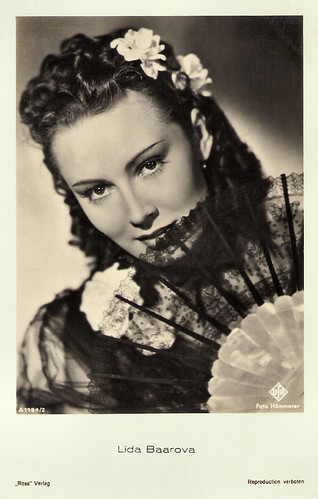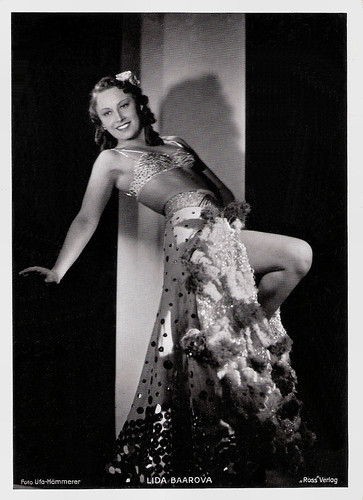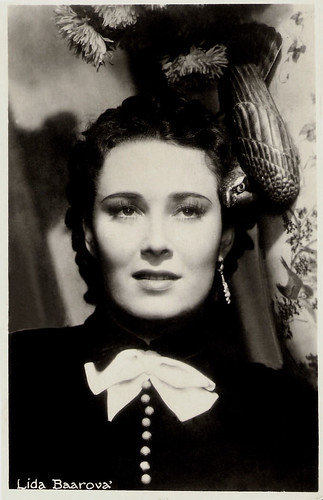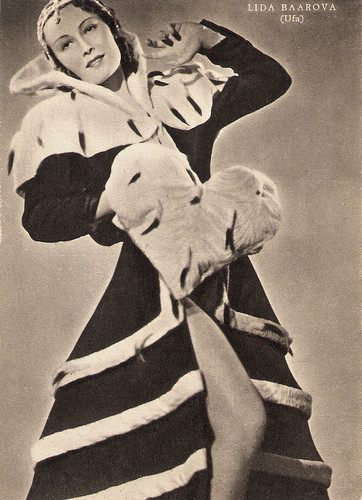
German postcard by Ross Verlag, no. A 1772/1, 1937-1938. Photo: Sandau, Berlin. Collection: Didier Hanson.

German postcard by Ross Verlag, no. A 1984/1, 1937-1938. Photo: Hämmerer / Ufa.

German postcard by Ross Verlag, no. A 1984/2, 1937-1938. Photo: Hämmerer / Ufa.
From Prague to Berlin
Lída Baarová was born Lidmila Babková in Prague, Austria-Hungary (now Czech Republic) in 1914. Her father was a civil servant, her mother appeared in several theatre plays and her younger sister, Zorka Janů, also was a film actress. From 1927 on, Lidmila studied acting at the State Conservatory in Prague. At the age of 17, she made her film debut as Lída Baarová in the Czech comedy Kariéra Pavla Camrdy/Pavel Čamrda's Career (Miroslav Josef Krnanský, 1931) starring Vladimír Borský. The film was a success but Lída had to leave the conservatory while students could not accept film roles. It did not matter.
The following year she played the lead in the comedies Madla z cihelny/The Brickmaker's Daughter (Vladimír Slavínský, 1932) with Hugo Haas, and Lelícek ve sluzbách Sherlocka Holmese/Lelícek in the service of Sherlock Holmes (Karel Lamač, 1932) featuring Martin Fric as Sherlock Holmes. Director Karel Lamač a.k.a. Carl Lamac and Baarová reportedly had an affair. The exceptionally beautiful actress starred in a dozen more Czech films, performed on stage and recorded some songs before she was discovered by a talent scout for the Ufa in 1934. Baarova left Prague for Berlin, where the Ufa studio groomed her as a star. At the set of the drama Barcarole (Gerhard Lamprecht, 1935), she met German actor Gustav Fröhlich, who became her new lover. The film was a success and the couple starred in several films together, such as Leutnant Bobby, der Teufelskerl/A Devil of a Fellow (Georg Jacoby, 1935) and Die Stunde der Versuchung/The Hour of Trial (Paul Wegener, 1936).
After Fröhlich had divorced his wife, the Jewish operetta star Gitta Alpár, he and Baarová moved to a villa on the picturesque Wannsee. There they lived near to the residence of Joseph Goebbels. Goebbels was the propaganda minister in Adolf Hitler's National Socialist government, with a decisive voice in German film production. Baarová met Goebbels at the Olympic Games of 1936. He ardently pursued her, entertaining her in his villa and lavishing her with expensive gifts. They started a relationship that lasted over two years.
In 1937, she received a job offer from Hollywood but turned it down. Later she would regret it and claimed to her biographer Josef Škvorecký: "I could have been as famous as Marlene Dietrich." For a while, her affair with the Propaganda Minister did her career no harm. She starred as an exotic vamp in such films as Patrioten/Patriots (Karl Ritter, 1937) with Mathias Wieman, Die Fledermaus/The Bat (Paul Verhoeven, Hans H. Zerlett, 1937) with Hans Söhnker, and the Fyodor Dostoevsky adaptation Der Spieler/The Gambler (Gerhard Lamprecht, 1938). She also had stage engagements at the prestigious Deutsche Theater and the Volksbühne.
However, the liaison caused serious complications between Goebbels and his wife Magda. Hitler was furious, refusing Goebbels's permission to divorce Magda and marry Baarová. Instead, he commanded Goebbels never to see his mistress again. Through the head of the Berlin police, Hitler ordered her extradition. Baarová was barred from appearing in films or plays and even from attending social functions. She was pursued by the Gestapo, who organised hecklers to shout ‘Whore’ when she defiantly attended the premiere of her film, Der Spieler.

Czech postcard, no. 448. Photo: Ströminger, Praha (Prague). Collection: Marlene Pilaete.

German postcard by Ross Verlag, no. 9021/1, 1935-1936. Photo: Ufa / Lindner. Lida Baarova and Gustav Fröhlich in Barcarole (Gerhard Lamprecht, 1936).

German postcard by Ross Verlag, no. 9228/1, 1935-1936. Photo: Willinger, Wien. Lida Baarova and Gustav Fröhlich.

German postcard by Ross Verlag, no. 9758/1, 1935-1936. Photo: Ufa / Euphono Film. Lida Baarova and Gustav Fröhlich in Die Stunde der Versuchung/The Hour of Temptation (Paul Wegener, 1936).
From Berlin to Prague to Rome
In 1939, Lída Baarová fled to Prague and there she continued to play in films like Ohnivé léto/Fiery Summer (Frantisek Cáp, Václav Krska, 1939), Dívka v modrém/Girl in blue (Otakar Vávra, 1940), Maskovana milenka/Masked Paramour (Otakar Vávra, 1940) with Ewald Balser, and Zivot je krásný/Life Is Beautiful (Ladislav Brom, 1940).
But the Germans invaded Prague in March 1939, and soon she could not continue to film in her homeland. In 1942, she moved on to Benito Mussolini’s Italy, where she starred in such films as La Fornarina (Enrico Guazzoni, 1944) with Anneliese Uhlig, L'ippocampo/The Sea-Horse (Gian Paolo Rosmino, 1945) with Vittorio de Sica, and Vivere ancora/Still Alive (Nino Giannini, 1945) starring Gino Cervi.
After Allied troops occupied Italy, Lída Baarová returned to Prague. There she dated her old friend, German film idol Hans Albers. In April 1945, Lída Baarová left Prague for Germany, to join Albers in his country house on the shores of Lake Starnberg. On the way, she was taken into custody by the American military police, imprisoned in Munich, and later extradited to Czechoslovakia. Baarová was taken into custody on suspicion of collaboration with the Germans during the war. After a police hearing Baarová’s mother got a heart attack and died. Zorka Janů, who never had any ties to the Nazis, got as Baarová’s sister also a Berufsverbot to make films and committed suicide in 1946.
After 18 months of custody, Lída Baarová was released due to lack of evidence. While in custody, she was often visited by an admirer, theatrical agent Jan Kopecký. He was a close relative of the Czech Communist Minister of the Interior and hoped he could arrange Baarova's release from custody. Kopecký's prominent relative disapproved of this and Kopecký himself faced persecution. Kopecký and Lída Baarová married in 1947, formed an itinerant troupe playing marionettes and fled to Austria.
From there, Kopecký immigrated to Argentina, leaving Lída behind to recuperate in a sanatorium. In Austria, Lída attempted a comeback, but Anton Walbrook withdrew from a film where he was cast with her. To escape the resulting negative media, she left for Argentina, where she lived in poverty. In 1950, she decided to return to Italy. Her husband stayed in Argentina and they were divorced in 1956.

Large German card by Ross Verlag. Photo: Euphono-Film / Tobis. Lida Baarova and Albrecht Schoenhals in Einer Zuviel an Bord/One Too Many on Board (Gerhard Lamprecht, 1935).

German card by Ross-Verlag. Photo: Hämmerer / Ufa. Lída Baarová in Patrioten/Patriots (Karl Ritter, 1937).

German card by Ross-Verlag. Photo: Hämmerer / Ufa.
Fellini
Back in Italy, Lida Baarová appeared in several films, including La bisarca/The Transporter (Giorgio Simonelli, 1950) with comedian Peppino De Filippo and Gli amanti di Ravello/The Lovers of Ravello (Luigi Capuano, 1951) opposite Gabriele Ferzetti.
Her best-known film is I Vitelloni/The Loafers (Federico Fellini, 1953), where she played the wife of a rich merchant. Later films include Pietà per chi cade/Compassion for those who fall (Mario Costa, 1954) starring Amedeo Nazzari and the Spanish production Miedo/Fear (León Klimovsky, 1956) in which she played the wife of Antonio Vilar. Her final film was the war film Il cielo brucia/The Sky Burns (Giuseppe Masini, 1958) with Amedeo Nazzari and Antonella Lualdi.
In 1958, Baarova moved to Salzburg, In 1960, she began her theatrical comeback at the Theater an der Berliner Allee in Düsseldorf in a play by Claude Magnier. She married Swedish physician Kurt Lundwall in 1969 (some sources say 1972), who was 20 years her senior. By 1975 she was appearing in the German stage version of Rainer Werner Fassbinder's 'The Bitter Tears of Petra Von Kant'.
In the 1990s, after the fall of Communism, Baarová reappeared on the cultural scene of the Czech Republic. With the help of the Czech author Josef Škvorecký she published 1983 the autobiography 'Útěky' (Escapes) and in 1991 followed 'Život sladké hořkosti' (The Sweet Bitterness of My Life). In this memoir, she described life in the Nazi upper echelons, where elegantly dressed ministers mingled with the film world elite. The short documentary Sladke horkosti Lidy Baarove/Lída Baarová's Bittersweet Memories (1995) won an award at the 1996 Art Film Festival in Trenčianske Teplice, Slovakia.
Lida Baarová suffered from Parkinson's disease and she died in 2000 in Salzburg, Austria. She was 86. She lived alone on the estate she inherited after the death of her second husband, Dr. Lundwall, who passed away in 1972 (some sources say 1980). In her autobiography, she stated that later in her life she regretted that she had been mixed up in ‘the history’. But at that time she was very young and ‘foolish’ and couldn't help seeing Goebbels. However, it is doubtful that she ever really felt guilt about her past. "There's no doubt that Goebbels was an interesting character," she observed in 1997, "a charming and intelligent man and a very good storyteller. You could guarantee that he would keep a party going with his little asides and jokes." Her ashes were interred in Prague's Strašnice cemetery, where she rests with her parents and her sister Zorka Janů.

German postcard by Agfa.

German postcard by Linden-Verlag, Leipzig, a supplement of the magazine Unterm Lindenbaum, no. V/21. Photo: Binder.

Italian postcard by Rizzoli, Milano, 1939, XVIII. Photo: Hämmerer / Ufa.
Lida Baarová sings Růže nad moji mrizi in Dívka v modrém/Girl in blue (1940). Source: Filmexporthomevideo (YouTube).
Sources: Peter Conradi (The Sunday Times), The Guardian, Wolf Oschlies (Shoa.de - now defunct), Wikipedia (German and English), and IMDb.
This post was last updated on 27 May 2024.
No comments:
Post a Comment